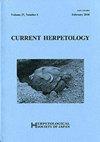Does an Asian Natricine Snake, Rhabdophis tigrinus, Have Chemical Preference for a Skin Toxin of Toads?
IF 0.7
4区 生物学
Q4 ZOOLOGY
引用次数: 4
Abstract
Abstract: Several Asian natricine snakes possess special organs called nuchal glands. Previous studies showed the nuchal glands of Rhabdophis tigrinus contain cardiac steroidal toxins known as bufadienolides (BDs) that are sequestered from toads consumed as prey. Recently, a congener has been found to ingest fireflies and sequester defensive BDs from them. As amphibians are probably the plesiomorphic diet of Rhabdophis species, it is presumed that a dietary transition of toxin source from toads to fireflies has occurred within the radiation of Rhabdophis. Because snakes heavily rely on chemical cues to recognize their prey, we predicted that species of Rhabdophis are capable of detecting BDs. To test the prediction, we conducted chemical preference tests using adults and hatchlings of R. tigrinus. We presented seven stimuli (water, cologne, earthworm, cinobufagin [a compound of BDs], toad, frog, and lampyrine firefly) to them. Both adult and hatchling R. tigrinus showed a higher response to toads and frogs than the controls (water and cologne), but, contrary to our prediction, they did not respond to cinobufagin. Adult R. tigrinus did however show a higher response to lampyrine fireflies than the controls. Our data imply that chemical resemblance between toads and fireflies elicited the reaction in adult R. tigrinus, but the chemical substances remain unknown. To identify the proximate mechanisms of the unique shift from toad-eating to firefly-eating in the snakes, further investigation is necessary.亚洲产的蓖麻毒素虎对蟾蜍的皮肤毒素有化学偏好吗?
摘要:几种亚洲钠蛇有一种特殊的器官,叫做颈腺。先前的研究表明,虎蛙的珠心腺含有被称为蟾蜍内酯(BDs)的心脏甾体毒素,这些毒素与作为猎物食用的蟾蜍隔离。最近,人们发现了一种类似物可以吞噬萤火虫并从中隔离防御BD。由于两栖动物可能是Rhabdophis物种的蛇床虫,因此推测在Rhabdophophis的辐射范围内,毒素来源从蟾蜍向萤火虫的饮食转变已经发生。由于蛇严重依赖化学线索来识别猎物,我们预测Rhabdophis物种能够检测BD。为了验证这一预测,我们对母老虎的成虫和幼崽进行了化学偏好测试。我们向它们提供了七种刺激(水、古龙水、蚯蚓、华蟾素(一种BDs的化合物)、蟾蜍、青蛙和七叶树萤火虫)。成年和孵化的虎对蟾蜍和青蛙的反应都比对照组(水和古龙水)高,但与我们的预测相反,它们对华蟾素没有反应。然而,成年虎对七叶树萤火虫的反应确实比对照组更高。我们的数据表明,蟾蜍和萤火虫之间的化学相似性引发了成年虎的反应,但化学物质仍然未知。为了确定蛇从吃蟾蜍到吃萤火虫的独特转变的直接机制,有必要进行进一步的研究。
本文章由计算机程序翻译,如有差异,请以英文原文为准。
求助全文
约1分钟内获得全文
求助全文
来源期刊

Current Herpetology
Agricultural and Biological Sciences-Animal Science and Zoology
CiteScore
1.20
自引率
14.30%
发文量
20
期刊介绍:
Current Herpetology publishes original research articles on amphibians and reptiles. It is the official journal of the Herpetological Society of Japan and is a continuation of Acta Herpetologica Japonica (1964–1971) and Japanese Journal of Herpetology (1972-1999).
 求助内容:
求助内容: 应助结果提醒方式:
应助结果提醒方式:


